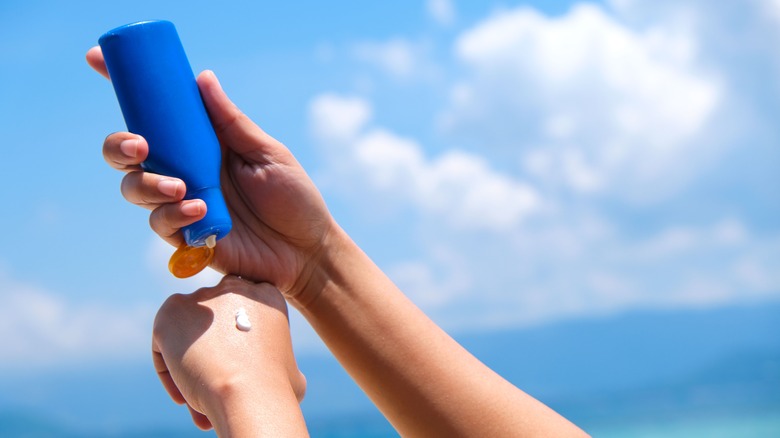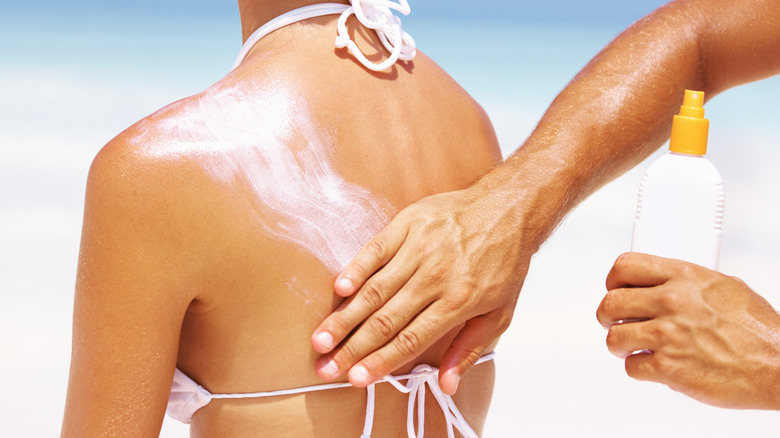How To Keep Your Skin Healthy While At The Beach
Beach therapy takes the art of unwinding to the next level. Aimless, pleasure-focused activities like lounging in natural sunshine with toes buried in warm sand and going on breezy sunset sails have therapeutic effects on our mind and body. Not only does spending time on the beach every once in a while give us a much-needed change of scenery and boost our energy, but it also nurses our stressed minds back to health, helping us to return to our day-to-day life with a fresh perspective and a newfound inspiration to embark on new adventures, according to a study in the Journal of Environmental Psychology.
Although a beach vacation has many perks, it's not without risks. Although a sun soak can help our skin make vitamin D — a nutrient needed to keep bones and muscles healthy — too much sun exposure can cause sunburns and dry your skin out. "The more sun exposure you have, the earlier your skin ages," says cancer prevention expert Dr. Barnett S. Kramer to NIH News in Health. Technically speaking, there's no point in hitting the beach if you prefer to stay inside to avoid getting fried. The good news is: You can still have fun in the sun without your skin paying the price. That's why we're sharing with you our dermatologist-approved ways to keep your skin happy as you're having a whale of a time.
Apply and reapply sunscreen
Although applying and reapplying sunscreen when outdoors is an absolute given, it's a habit worth stressing. "The sea and UV light will especially dry out the skin," dermatologist Sharyn Laughlin tells Real Simple. Sunscreen is like an armor against the sun, preventing blazing UV rays from penetrating the skin. Without sunscreen, the skin is exposed to all kinds of sun damage that can lead to uneven pigmentation, premature aging, and skin cancer. UVA rays from sunlight can penetrate the skin and damage essential proteins and fibers like collagen and elastin, causing your skin to dry out and form wrinkles. More intense than UVA, UVB rays can harm the DNA in skin cells directly, causing sunburn as well as skin cancer.
If you're spending time outdoors, one layer of sunscreen for your face and your body is not enough. According to Nivea, you should apply sunscreen at least 30 minutes before going out, and reapply every two hours as needed. If you're taking part in water activities or sweating profusely, take care to reapply your sunscreen more often. For convenient protection, a broad-spectrum sunscreen with an SPF of 30 or higher should be enough.
Apply moisturizer before sunscreen
Exposure to a cocktail of salt, sun, and sand can irritate and dry out skin, especially for those with sensitive or dry skin. Therefore, slathering up with a moisturizer before arriving at the beach will help keep your skin smooth and comfy throughout the day. Now, what you might be wondering is whether it's a good idea to take the shortcut and apply a moisturizer with SPF and skip the sunscreen. Having a moisturizer powered with sun protection in your arsenal is a great way to streamline your daily skincare routine. However, it cannot provide as much sun protection as a pure sunscreen does.
Dermatologist Jeanine Downie says via MbgLifestyle: "I definitely feel that moisturizer combined with sunscreen decreases the effectiveness of sunscreen." Pointing out that a moisturizer may not be able to actually provide the level of SPF protection that it boasts on its label due to the dilution caused by other ingredients, dermatologist Nava Greenfield tells Byrdie that it's a better idea to apply moisturizer first before slathering up with a sunscreen with an SPF of 30 or higher at least 15 minutes before going into the sun. The rationale behind applying these products separately, according to Dr. Greenfield, is to not let any other formula interfere with sunscreen's capacity to measure up to its SPF number and effectively form a protective layer on top of the skin.
Wear a wide-brimmed hat and shades
Sunscreen is just a part of sun protection. To enjoy yourself in the sun safely and stylishly, wear a sun-safe hat to cover your head, back of neck, ears, and a large part of your face. According to Cancer Council NSW, a hat — like a broad-brimmed hat, a bucket hat, or legionnaire-style hat — provides good protection against sunlight, lowering the amount of UV radiation that reaches your eyes by half. A hat that's considered sun-safe must have good ventilation and a broad brim so that it provides shade to the whole face without obscuring vision. It must also be made of close-weave fabric to prevent UV rays from getting through it and have a dark lining to minimize the amount of UV radiation being reflected on the face and eyes.
It's also important to wear polarized and UV-protected sunglasses while outdoors — rain or shine. "Whether it's winter or summer, cloudy or sunny, you're always subject to ultraviolet exposure," says ophthalmologist Dr. Elliot Levine from Piedmont Healthcare. UV rays can damage your delicate eyelid skin, cause a sunburn of the cornea, and heighten your risk of developing a cataract or macular degeneration. Having a pair of sunglasses handy allows you to be stylish and safe at the same time.
Wear UPF clothing
When it comes to stylish swimwear or slinky outfits for afternoon sunnings, do your skin a favor and opt for garments that have Ultraviolet Protection Factor (UPF), an indicator of how much UVB and UVA can reach your skin through the fabric, according to the Skin Cancer Foundation. A UPF 50 fabric, for example, blocks 98% of the sun's rays while allowing 2% to get through, which significantly minimizes your risks of sun exposure.
UPF rating aside, it's also worth keeping in mind that the darker the fabrics are, the greater UV protection they provide your skin, according to REI Co-op . For instance, a deep red wetsuit will protect your skin better than the one in a lighter pink shade. Densely woven fabrics such as denim, canvas, wool, or synthetic fibers offer more UV protection than sheer, loosely woven garments. One way to estimate how much sun protection a garment has is by holding it up to the light. If it's sheer and thin enough for you to see through it, it means UV rays can penetrate the fabric and reach your skin.
Avoid staying in direct sunlight for too long and stay hydrated
If possible, avoid staying in direct sunlight for too long. For instance, you can move your outdoor activities to more shaded areas where you can bask in natural daylight and ocean breeze without the sun blazing down on your skin. Staying in the shade beneath an umbrella, tree, or other shelter can lower your risk of skin cancer and solar damage, according to the Centers for Disease Control and Prevention.
Healthy skin starts from within. While on the beach, remember to drink lots of water to keep your body hydrated and maintain the freshness of your skin. If water is too plain for a fun-in-the-sun day, try coconut water, watermelon juice, or an electrolyte-rich beverage for a flavorful, hydrating drink. Alcoholic beverages might make your time on the beach more exciting, but they won't hydrate you. If anything, drinking alcohol makes you urinate more. When your kidneys excrete more water than the volume that goes into your body, there is less fluid in your blood and you'll soon feel dehydrated, according to dietitian Alissa Rumsey (via Food & Wine).





